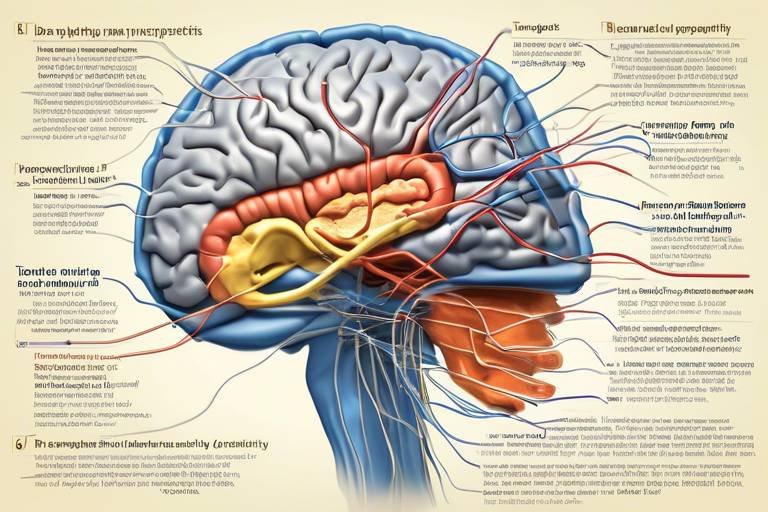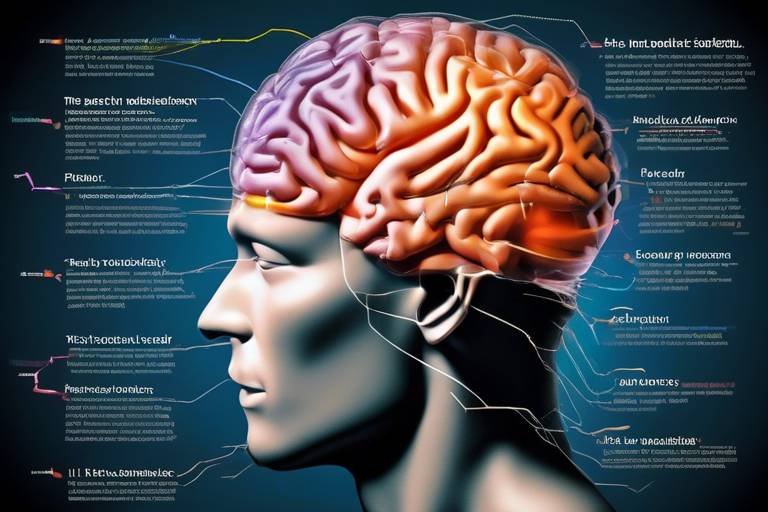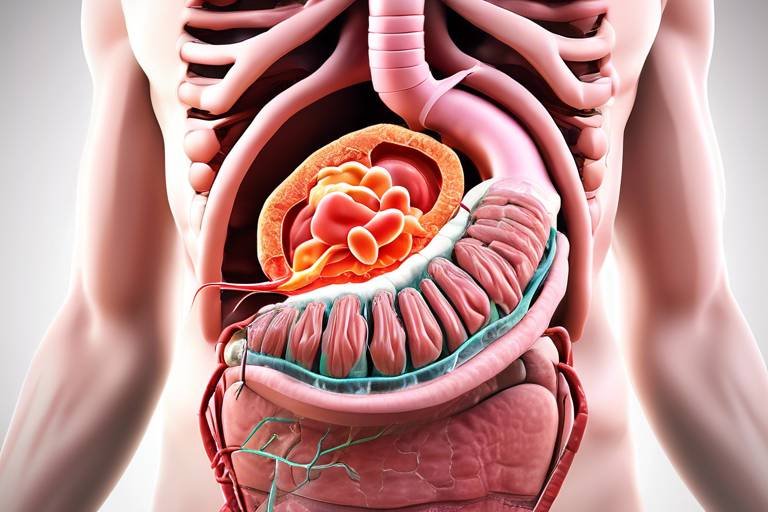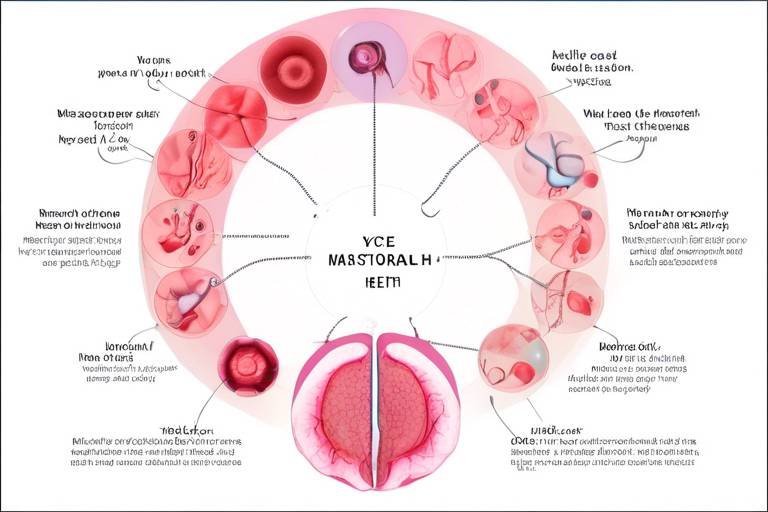The Biology of Neuroplasticity - How Our Brain Adapts
Have you ever wondered how your brain learns new things or recovers from injuries? The answer lies in a fascinating phenomenon known as neuroplasticity. This remarkable ability of our brain to reorganize itself by forming new neural connections is not just a scientific curiosity; it has profound implications for how we learn, recover, and adapt throughout our lives. Imagine your brain as a bustling city, where every street can change direction or be rebuilt entirely based on new experiences and needs. That's neuroplasticity at work!
Neuroplasticity is the brain's way of adapting to various challenges and experiences. Whether you're learning a new skill, recovering from a stroke, or even just facing the daily grind of life, your brain is constantly reshaping itself. This adaptability is crucial for survival, allowing us to learn from our environment and adjust our behaviors accordingly. The more we understand about this process, the better equipped we are to harness its power for personal growth and rehabilitation.
At its core, neuroplasticity involves two main types: functional and structural. Functional neuroplasticity refers to the brain's ability to transfer functions from damaged areas to healthy ones, essentially rerouting traffic in our neural pathways. Imagine if a road in your city was blocked; instead of being stuck, traffic could find a new route to reach its destination. On the other hand, structural neuroplasticity involves physical changes in the brain's structure, such as the strengthening of synaptic connections or the formation of new neurons. This is akin to building new roads or bridges in our brain's city to accommodate new learning and experiences.
The significance of neuroplasticity cannot be overstated. It opens up new avenues for education, therapy, and personal development. For instance, understanding how our brains adapt can lead to more effective teaching strategies that align with how we naturally learn. Similarly, therapists can utilize neuroplastic principles to design rehabilitation programs that help individuals recover lost functions after neurological injuries. The brain's ability to adapt is not just a fascinating scientific fact; it's a powerful tool that can be leveraged for positive change.
In conclusion, the biology of neuroplasticity showcases the incredible adaptability of our brains. As we continue to explore this dynamic field, we uncover new ways to enhance our learning, recovery, and overall mental health. So the next time you tackle a new challenge or work through a difficult period, remember that your brain is not just a static organ; it's a living, changing entity that can grow and adapt in remarkable ways.
- What is neuroplasticity? Neuroplasticity is the brain's ability to reorganize itself by forming new neural connections in response to learning, experience, or injury.
- How does neuroplasticity work? Neuroplasticity works through two main processes: functional neuroplasticity, which transfers functions from damaged areas to healthy ones, and structural neuroplasticity, which involves physical changes in the brain's structure.
- Can neuroplasticity help with recovery from brain injuries? Yes, neuroplasticity plays a crucial role in recovery from brain injuries by allowing the brain to adapt and reroute functions to undamaged areas.
- What factors can influence neuroplasticity? Factors such as age, environment, lifestyle choices, exercise, and nutrition can significantly influence the brain's ability to adapt and reorganize.

[Understanding Neuroplasticity]
Neuroplasticity is one of the most awe-inspiring aspects of our brain's functionality. It refers to the brain's remarkable ability to reorganize itself by forming new neural connections throughout life. Imagine your brain as a vast city of interconnected roads and highways; when a road gets blocked, the city finds new routes to ensure traffic flows smoothly. This is exactly how neuroplasticity works! It allows our brains to adapt to new information, experiences, and even injuries, making it an essential component of learning and recovery.
At its core, neuroplasticity is about flexibility. The brain is not a static organ; instead, it is dynamic and ever-changing. This adaptability is crucial for various cognitive processes, including learning, memory, and recovery from injuries. When we learn something new, our brain forms new pathways, strengthening the connections between neurons. This is why practice makes perfect—repetition helps engrain those pathways, making the information easier to access later.
Neuroplasticity can be categorized into two primary types: functional neuroplasticity and structural neuroplasticity. Functional neuroplasticity is like a backup system for your brain. When one area is damaged, other parts of the brain can take over its functions. For example, if someone suffers a stroke that affects their speech, other areas of the brain may adapt to help them regain that ability. On the other hand, structural neuroplasticity involves physical changes in the brain’s structure itself, such as the growth of new neurons or the strengthening of synaptic connections. This type of plasticity is often seen in response to learning and environmental changes.
Understanding neuroplasticity is not just an academic exercise; it has profound implications for how we approach education, therapy, and mental health. By recognizing that our brains can change and adapt, we can develop more effective strategies for learning and recovery. This understanding empowers educators to create environments that foster growth and encourages therapists to design rehabilitation programs that leverage the brain's inherent adaptability.
In summary, neuroplasticity is the brain's superpower. It allows us to learn, adapt, and recover throughout our lives. As we continue to explore this fascinating field, we uncover new ways to harness the brain's potential, paving the way for innovative approaches in education and rehabilitation.

[Types of Neuroplasticity]
Neuroplasticity is not a one-size-fits-all concept; it actually encompasses a variety of mechanisms that allow our brains to adapt and change. Understanding the different types of neuroplasticity can help us appreciate how our brains learn, recover, and evolve over time. Essentially, there are two main types of neuroplasticity: functional neuroplasticity and structural neuroplasticity. Each of these plays a unique role in how we process information, recover from injuries, and reshape our cognitive abilities.
Functional neuroplasticity refers to the brain's remarkable ability to transfer functions from damaged areas to healthy ones. Imagine your brain as a bustling city where each neighborhood has specific functions. When one neighborhood suffers a setback, such as damage from a stroke, the city can reroute traffic, allowing other neighborhoods to take over those essential functions. This is crucial for recovery, as it enables individuals to regain lost skills and abilities.
On the other hand, structural neuroplasticity involves physical changes in the brain's structure. This type of neuroplasticity is like renovating a house; as you learn new skills or have new experiences, the wiring and connections within your brain are remodeled. This remodeling can lead to the strengthening of existing neural pathways or the creation of entirely new ones. Such changes are vital for learning and memory, illustrating how our experiences can shape our brain's architecture.
To summarize, both functional and structural neuroplasticity are essential for our brain's adaptability. They allow us to learn new information, recover from injuries, and even adapt to new environments. Understanding these types can open up exciting avenues for education and rehabilitation, as we harness the brain's inherent ability to change and grow.
- What is neuroplasticity? Neuroplasticity is the brain's ability to reorganize itself by forming new neural connections throughout life.
- What are the main types of neuroplasticity? The two main types are functional neuroplasticity and structural neuroplasticity.
- How does functional neuroplasticity work? It allows the brain to transfer functions from damaged areas to healthy ones, aiding recovery from injuries.
- What is structural neuroplasticity? This involves physical changes in the brain's structure as a result of learning and experience.
- Can neuroplasticity be enhanced? Yes, factors like exercise, nutrition, and mental engagement can positively influence neuroplasticity.

[Functional Neuroplasticity]
Functional neuroplasticity is a captivating aspect of how our brains adapt to challenges and injuries. Imagine your brain as a bustling city, with roads representing neural pathways. When certain roads are blocked—due to injury or damage—your brain finds alternative routes to ensure that essential functions can continue. This remarkable ability to transfer functions from damaged areas to healthy ones is what we call functional neuroplasticity.
Take a moment to think about a stroke survivor. After experiencing a stroke, many individuals face challenges in performing everyday tasks. However, through rehabilitation and targeted exercises, their brains can reorganize and create new pathways, allowing them to regain lost skills. This isn't just a hopeful notion; it's backed by science. Research has shown that with the right interventions, the brain can effectively rewire itself, showcasing its resilience and adaptability.
One of the most inspiring examples comes from individuals who have suffered traumatic brain injuries. Many of these individuals undergo intensive therapy that focuses on repetitive practice and task-oriented activities. As they engage in these activities, their brains begin to form new connections, compensating for the areas that were affected. This process is akin to learning to ride a bike again after a long break; with practice, the skills come back, and in some cases, they even become stronger than before.
However, it's essential to acknowledge that functional neuroplasticity has its limitations. Not every individual will experience the same level of recovery, and various factors can influence the extent of neuroplastic changes. For instance, age, the severity of the injury, and the timing of rehabilitation play crucial roles in determining outcomes. Early intervention is often key; the sooner rehabilitation begins, the more likely the brain can adapt and recover. This is why recognizing the signs of brain injury and seeking help promptly is vital.
In summary, functional neuroplasticity is a powerful testament to the brain's ability to heal and adapt. By understanding this process, we can develop better therapeutic strategies that not only aid in recovery but also enhance our overall cognitive abilities. The brain's potential for change is not just a fascinating concept; it offers hope for countless individuals seeking to reclaim their lives after injury.
- What is functional neuroplasticity?
Functional neuroplasticity refers to the brain's ability to transfer functions from damaged areas to healthy ones, allowing for recovery and adaptation. - How does functional neuroplasticity help in rehabilitation?
Through targeted rehabilitation techniques, individuals can engage in activities that stimulate the brain to form new pathways, leading to the recovery of lost skills. - Are there limits to functional neuroplasticity?
Yes, factors such as age, severity of injury, and timing of intervention can influence the extent of recovery through functional neuroplasticity.

[Examples of Functional Neuroplasticity]
Functional neuroplasticity is nothing short of a miracle. Imagine a world where the brain can adapt, heal, and even rewire itself after injury. This isn’t science fiction; it’s a reality that many individuals experience every day. One of the most compelling examples of this phenomenon can be seen in stroke survivors. After a stroke, certain areas of the brain may be damaged, which can lead to loss of motor skills or speech. However, through targeted rehabilitation, other parts of the brain can take over these functions, allowing individuals to regain their abilities.
Consider the story of John, a 45-year-old man who suffered a stroke that affected his right side, rendering him unable to move his arm. Through consistent physical therapy, which included repetitive tasks and exercises, John’s brain began to form new connections. Over time, he was able to regain movement in his arm, demonstrating the brain's remarkable ability to adapt. This is a prime example of how functional neuroplasticity works in real life, showcasing the brain's resilience and adaptability.
Another inspiring example can be found in individuals who have experienced traumatic brain injuries (TBIs). Take Sarah, a young athlete who suffered a concussion during a football game. Initially, she struggled with memory and concentration, but with the help of cognitive rehabilitation exercises, her brain was able to reorganize itself. Gradually, she regained her cognitive functions and returned to her normal activities. This transformation highlights the importance of early intervention and tailored rehabilitation strategies in harnessing functional neuroplasticity.
Additionally, research has shown that musicians often exhibit enhanced neuroplasticity. Their brains are wired differently due to years of practice and training. For instance, studies reveal that when musicians learn new pieces, their brains create new neural pathways, allowing them to process information more efficiently. This not only enhances their musical skills but also demonstrates how functional neuroplasticity can be leveraged in various fields, from art to athletics.
To further illustrate the concept of functional neuroplasticity, here’s a brief comparison of different rehabilitation techniques that have been shown to yield positive results:
| Technique | Description | Benefits |
|---|---|---|
| Constraint-Induced Movement Therapy | Restricts the use of the unaffected limb to encourage use of the affected limb. | Improves motor function in the affected limb. |
| Mirror Therapy | Uses a mirror to create the illusion of movement in the affected limb. | Enhances motor recovery and reduces pain. |
| Virtual Reality Rehabilitation | Incorporates virtual environments to practice movement and coordination. | Engages patients and promotes motivation during recovery. |
In conclusion, the examples of functional neuroplasticity are not only fascinating but also essential for understanding how we can recover from injuries and improve our skills. From stroke survivors regaining movement to musicians enhancing their craft, the brain's ability to adapt is a powerful testament to human resilience. As we continue to explore this field, we unlock new potential for rehabilitation and personal growth, inspiring hope and change in countless lives.
- What is functional neuroplasticity? Functional neuroplasticity refers to the brain's ability to shift functions from damaged areas to healthy ones, particularly after injuries.
- How can rehabilitation techniques enhance neuroplasticity? Techniques such as constraint-induced movement therapy and mirror therapy can stimulate the brain to form new connections, aiding in recovery.
- Can neuroplasticity occur at any age? Yes, neuroplasticity can occur throughout a person’s life, although it may be more pronounced in younger individuals.

[Limitations of Functional Neuroplasticity]
While the concept of functional neuroplasticity is incredibly inspiring, showcasing the brain's ability to adapt and recover, it is essential to recognize that this phenomenon is not without its limitations. Just like a plant that requires the right conditions to thrive, our brain's ability to reorganize itself can be influenced by various factors that may hinder recovery.
One of the primary limitations is the extent of the damage sustained. For instance, if a significant portion of the brain is affected, there may not be enough healthy tissue left to take over the lost functions. This is akin to trying to rebuild a house after a natural disaster; if the foundation is severely compromised, no amount of renovation can restore it to its former glory.
Moreover, the timing of intervention plays a crucial role. Research indicates that the earlier rehabilitation begins after an injury, the better the chances of recovery. Delayed treatment can result in the brain's plasticity mechanisms becoming less effective over time. Imagine a window of opportunity that slowly closes; if you wait too long, you might miss your chance to make significant gains.
Additionally, individual differences in brain chemistry and genetics can affect how well someone responds to rehabilitation efforts. Factors such as age, overall health, and pre-existing conditions can act as barriers to achieving desired outcomes. For example, younger individuals often exhibit more robust neuroplasticity compared to older adults, who may find it more challenging to recover from injuries.
Finally, psychological factors such as motivation and mental health can also influence functional neuroplasticity. A person who is optimistic and engaged in their recovery process is more likely to experience positive outcomes than someone who feels hopeless or disengaged. This highlights the importance of a supportive environment, where encouragement and mental well-being play pivotal roles in recovery.
In summary, while functional neuroplasticity holds tremendous potential for rehabilitation, it is essential to acknowledge its limitations. Understanding these factors can help healthcare providers tailor interventions that maximize recovery and support individuals on their journey back to functional independence.
- What is functional neuroplasticity? Functional neuroplasticity refers to the brain's ability to transfer functions from damaged areas to healthy ones, enabling recovery from injuries.
- Can older adults benefit from functional neuroplasticity? Yes, older adults can benefit, but they may experience more challenges compared to younger individuals due to age-related changes in the brain.
- How important is early intervention in recovery? Early intervention is crucial; the sooner rehabilitation begins, the better the chances of successful recovery.
- What role does motivation play in neuroplasticity? Motivation significantly impacts recovery outcomes, as individuals who are engaged and optimistic tend to experience better results.

[Structural Neuroplasticity]
When we talk about structural neuroplasticity, we're diving into the brain's incredible ability to physically change its structure in response to learning and experience. Think of your brain as a bustling city, where every street and building represents a neural pathway or synapse. Just as a city evolves with new constructions and renovations, our brains can rewire and reshape themselves based on what we learn and how we interact with the world around us.
One of the most fascinating aspects of structural neuroplasticity is that it doesn't just happen in response to major life events; it occurs constantly, at a cellular level, as we engage in everyday activities. For instance, when you learn a new skill, like playing the guitar or speaking a new language, your brain forms new connections and strengthens existing ones. This process is akin to paving new roads in our city, making it easier for information to travel and for us to access our memories and skills.
Research has shown that the brain can create new neurons—a process called neurogenesis. This is particularly evident in the hippocampus, a region associated with memory and learning. The more we challenge our brains with novel experiences, the more adaptable and resilient they become. For example, studies have indicated that engaging in activities that require concentration, such as puzzles or strategy games, can lead to an increase in the number of neural connections, effectively expanding the brain's infrastructure.
However, it's essential to recognize that structural neuroplasticity isn't just about building new connections; it's also about pruning away the unnecessary ones. Just like a gardener trims overgrown branches to promote healthy growth, our brains eliminate weaker synapses to enhance overall efficiency. This process is crucial for optimizing our cognitive functioning, ensuring that the most relevant and frequently used pathways remain robust.
To illustrate the significance of structural neuroplasticity, consider the following table that summarizes key differences between functional and structural neuroplasticity:
| Type of Neuroplasticity | Description | Examples |
|---|---|---|
| Functional Neuroplasticity | Reorganization of brain functions from damaged areas to healthy areas. | Recovery from stroke, rehabilitation after injury. |
| Structural Neuroplasticity | Physical changes in the brain's structure due to learning and experience. | Learning a new skill, memory formation. |
In summary, structural neuroplasticity plays a vital role in our ability to adapt and learn throughout our lives. By understanding how our brains can physically change, we can better appreciate the importance of lifelong learning and cognitive challenges. Whether it's picking up a new hobby, engaging in social interactions, or simply staying curious, every experience contributes to the ever-evolving landscape of our minds. So, why not embrace the journey of learning and allow your brain to flourish?
- What is neuroplasticity? Neuroplasticity is the brain's ability to reorganize itself by forming new neural connections throughout life.
- How does structural neuroplasticity differ from functional neuroplasticity? Structural neuroplasticity refers to physical changes in the brain's structure, while functional neuroplasticity involves the reassignment of functions from damaged areas to healthy ones.
- Can anyone experience neuroplasticity? Yes, neuroplasticity is a universal capability of the brain, though factors like age and lifestyle can influence its effectiveness.
- How can I promote neuroplasticity? Engaging in new learning experiences, physical exercise, and maintaining a balanced diet can all support neuroplasticity.

[Factors Influencing Neuroplasticity]
Neuroplasticity is an incredible phenomenon that allows our brains to adapt and change throughout our lives. However, it doesn’t happen in a vacuum. Various factors play a crucial role in either enhancing or hindering this remarkable ability. Understanding these factors can empower us to make choices that promote healthier brain function and adaptability.
One of the most significant factors influencing neuroplasticity is age. Research shows that younger brains are generally more plastic than older ones. This is largely due to the fact that during childhood and adolescence, our brains are in a state of rapid development. They are more receptive to forming new connections and reorganizing existing ones. However, this doesn't mean that adults can't experience neuroplasticity; it just may require more effort and specific strategies to harness it effectively.
Environment is another critical factor. A stimulating environment filled with learning opportunities, social interactions, and novel experiences can significantly boost neuroplasticity. Think of it as a garden: the more diverse and rich the soil, the more vibrant and resilient the plants can grow. Conversely, a monotonous or stressful environment can stifle brain development and inhibit its ability to adapt. For instance, children raised in enriched environments, where they are encouraged to explore and learn, often show more advanced cognitive skills than those in less stimulating settings.
Moreover, lifestyle choices such as diet, exercise, and sleep play vital roles in neuroplasticity. A well-balanced diet rich in antioxidants, omega-3 fatty acids, and vitamins can support brain health. For example, foods like fatty fish, berries, and leafy greens are known to be particularly beneficial. Regular physical activity is equally important; it not only boosts blood flow to the brain but also encourages the release of neurotrophic factors that promote the growth of new neurons and synapses.
| Factor | Influence on Neuroplasticity |
|---|---|
| Age | Younger brains are generally more plastic, but adults can still adapt with effort. |
| Environment | Stimulating environments enhance learning and adaptability. |
| Lifestyle Choices | Diet, exercise, and sleep significantly impact brain health and neuroplasticity. |
Finally, mental health is a crucial component. Conditions such as chronic stress, anxiety, or depression can negatively affect neuroplasticity. When our mental health suffers, it can lead to a decrease in cognitive function and hinder our brain's ability to adapt. Therefore, managing stress through mindfulness practices, therapy, or relaxation techniques can be incredibly beneficial for maintaining a healthy brain.
In summary, neuroplasticity is influenced by a myriad of factors including age, environment, lifestyle choices, and mental health. By understanding and optimizing these elements, we can enhance our brain's ability to adapt and thrive. So, why not take a moment to reflect on your surroundings and habits? Small changes can lead to significant improvements in your brain's plasticity!
- What is neuroplasticity? Neuroplasticity is the brain's ability to reorganize itself by forming new neural connections throughout life.
- Can adults experience neuroplasticity? Yes, while younger brains are more plastic, adults can still harness neuroplasticity through specific strategies.
- How does exercise affect neuroplasticity? Regular physical activity promotes blood flow and the release of neurotrophic factors that support neuron growth.
- What role does diet play in neuroplasticity? A balanced diet rich in essential nutrients supports optimal brain function and adaptability.

[The Role of Exercise]
When it comes to neuroplasticity, one of the most exciting and accessible ways to enhance our brain's adaptability is through regular exercise. You might be surprised to learn that physical activity doesn't just benefit your body; it also plays a crucial role in reshaping your brain. Think of your brain as a garden; just as plants need sunlight and water to thrive, your brain requires movement and stimulation to grow new connections and pathways. But how exactly does exercise impact neuroplasticity? Let's dive in!
Research has shown that engaging in regular physical activity can lead to significant changes in brain structure and function. When you exercise, your heart pumps more blood, delivering essential nutrients and oxygen to your brain. This process helps to stimulate the production of neurotrophic factors, which are proteins that promote the survival and growth of neurons. One of the most notable of these is Brain-Derived Neurotrophic Factor (BDNF), often referred to as "miracle grow for the brain." Higher levels of BDNF are associated with improved learning, memory, and overall cognitive function.
Moreover, exercise can enhance your mood and reduce stress, which are both critical for optimal brain health. When you work up a sweat, your body releases endorphins, often dubbed the "feel-good" hormones. These not only elevate your mood but also create a more favorable environment for neuroplasticity to occur. In fact, studies indicate that people who engage in regular aerobic exercise tend to perform better on cognitive tasks than those who lead a sedentary lifestyle. Isn't that a compelling reason to lace up your sneakers?
To further illustrate the impact of exercise on neuroplasticity, consider the following findings from recent studies:
| Study | Findings |
|---|---|
| Erickson et al. (2011) | Older adults who participated in regular aerobic exercise showed increased hippocampal volume, which is crucial for memory. |
| Voss et al. (2010) | High levels of physical activity were linked to improved executive function and working memory in children. |
| Colcombe & Kramer (2003) | Aerobic fitness training led to significant improvements in cognitive performance across various age groups. |
As you can see, the evidence is compelling. But it's not just about hitting the gym or running marathons; even simple activities like walking, dancing, or yoga can foster neuroplasticity. The key is to find something you enjoy and make it a regular part of your routine. Remember, consistency is more important than intensity. So whether you're taking a brisk walk in the park or joining a dance class, every bit of movement counts toward enhancing your brain's ability to adapt and grow.
In conclusion, the role of exercise in promoting neuroplasticity is profound and multifaceted. By incorporating physical activity into your daily life, you are not only improving your physical health but also nurturing your brain's capacity to learn, adapt, and recover. So, the next time you think about skipping that workout, remember that your brain will thank you for every step you take!

[Nutrition and Neuroplasticity]
When it comes to the health of our brains, nutrition plays a pivotal role that cannot be overlooked. Just like a car needs the right fuel to run smoothly, our brains require a balanced diet rich in essential nutrients to function optimally and promote neuroplasticity. This incredible ability of our brains to adapt and reorganize itself hinges significantly on what we consume daily. So, what are the key nutrients that help enhance neuroplasticity?
One of the most important components is omega-3 fatty acids. Found in fatty fish like salmon, walnuts, and flaxseeds, these healthy fats are vital for maintaining the integrity of neuronal membranes and facilitating communication between brain cells. Research has shown that omega-3s can enhance cognitive functions and support the growth of new neurons, which is essential for learning and memory.
Next up, we have antioxidants. These powerful compounds, found in fruits and vegetables like blueberries, spinach, and kale, help combat oxidative stress, which can damage brain cells. By protecting our neurons from this damage, antioxidants contribute to the brain's ability to adapt and rewire itself. They essentially act as the body's defense system, keeping our brains sharp and resilient.
Another critical nutrient is vitamin B complex, which includes B6, B12, and folate. These vitamins are crucial for neurotransmitter synthesis and overall brain health. They help regulate mood and are involved in the formation of myelin, the protective sheath around neurons. A deficiency in these vitamins can lead to cognitive decline and hinder neuroplasticity.
Moreover, polyphenols found in foods like dark chocolate, green tea, and berries have been shown to promote neuroplasticity by enhancing synaptic function and increasing blood flow to the brain. This increased circulation can lead to improved cognitive performance and mental clarity.
To give you a clearer picture, here’s a
| Nutrient | Sources | Benefits for Neuroplasticity |
|---|---|---|
| Omega-3 Fatty Acids | Salmon, walnuts, flaxseeds | Supports neuronal integrity and communication |
| Antioxidants | Blueberries, spinach, kale | Protects neurons from oxidative stress |
| Vitamin B Complex | Leafy greens, eggs, dairy | Essential for neurotransmitter synthesis |
| Polyphenols | Dark chocolate, green tea, berries | Enhances synaptic function and blood flow |
Incorporating these nutrients into your diet can be a game-changer for your brain health. Think of it as giving your brain the tools it needs to build new connections and strengthen existing ones. It's not just about avoiding junk food; it's about fueling your brain with the right ingredients. So, next time you're planning your meals, consider how each food choice can impact your brain's adaptability and resilience.
Ultimately, maintaining a diet rich in these essential nutrients can help foster an environment where neuroplasticity thrives. Whether you're a student looking to enhance your learning capabilities or someone recovering from a brain injury, the right nutrition can significantly influence your brain's ability to adapt and grow. Remember, your brain is like a garden; the more you nourish it, the more it flourishes!
- What foods are best for brain health? Foods rich in omega-3 fatty acids, antioxidants, and vitamins B6, B12, and folate are excellent for brain health.
- Can diet really affect neuroplasticity? Yes, a balanced diet with essential nutrients can enhance the brain's ability to adapt and reorganize.
- How quickly can I see changes in my brain health with diet? While individual results vary, adopting a nutrient-rich diet can lead to improvements in cognitive function over time.

[Applications of Neuroplasticity]
Understanding neuroplasticity has opened up a world of possibilities across various fields, especially in education, therapy, and mental health. The concept that our brains can change and adapt based on our experiences has profound implications for how we teach, heal, and support individuals facing cognitive challenges. Imagine a world where learning is tailored to the brain's unique wiring, or where recovery from injury isn't just a dream but a reality. This is the power of neuroplasticity at work!
In the realm of education, educators are beginning to harness the principles of neuroplasticity to enhance learning outcomes. By understanding how the brain learns and adapts, teachers can develop innovative strategies that cater to individual learning styles. For instance, incorporating multisensory learning approaches can stimulate different areas of the brain, making the learning process more engaging and effective. Studies suggest that when students are actively involved in their learning process—through hands-on activities, discussions, and collaborative projects—they are more likely to retain information. This is a classic example of how neuroplasticity can shape educational practices.
Moreover, neuroplasticity has significant implications in therapeutic applications. Therapists are increasingly employing techniques that leverage the brain's ability to reorganize itself, particularly for individuals recovering from neurological conditions such as strokes or traumatic brain injuries. Rehabilitation programs often include targeted exercises that encourage the brain to form new neural pathways, effectively helping patients regain lost skills. For example, a stroke survivor may work with a therapist to relearn how to use their arm through repetitive tasks, gradually re-establishing connections in the brain that facilitate movement.
Additionally, the incorporation of technology in therapy, such as virtual reality and brain-computer interfaces, is revolutionizing how we approach recovery. These tools not only provide engaging environments for practice but also create opportunities for real-time feedback, further enhancing the brain's adaptive capabilities. The combination of traditional rehabilitation techniques with cutting-edge technology exemplifies the exciting future of neuroplasticity in therapy.
As we delve deeper into the applications of neuroplasticity, it's essential to recognize the role of mental health. Therapists are finding that understanding neuroplasticity can lead to more effective treatment plans for conditions like anxiety and depression. Techniques such as cognitive behavioral therapy (CBT) focus on changing thought patterns, which can physically alter the brain's structure over time. By challenging negative thoughts and behaviors, individuals can create new, healthier neural pathways, leading to improved mental well-being.
In summary, the applications of neuroplasticity are vast and varied. From reshaping educational practices to enhancing therapeutic techniques and improving mental health strategies, the ability of our brains to adapt is a game-changer. As research continues to unfold, we can expect even more innovative applications that will transform how we learn, heal, and grow.
- What is neuroplasticity? Neuroplasticity is the brain's ability to reorganize itself by forming new neural connections in response to learning, experience, or injury.
- How does neuroplasticity affect learning? Neuroplasticity allows the brain to adapt to new information and experiences, enhancing learning and retention.
- Can neuroplasticity help with recovery from brain injuries? Yes, therapies that utilize neuroplasticity can aid recovery by encouraging the brain to form new pathways and regain lost functions.
- What lifestyle factors influence neuroplasticity? Factors such as physical exercise, nutrition, and mental engagement can significantly enhance neuroplasticity.

[Neuroplasticity in Education]
Neuroplasticity is not just a fascinating concept relegated to the realm of neuroscience; it has profound implications for education. Imagine a classroom where every student, regardless of their starting point, has the potential to reshape their brain through learning. This is the power of neuroplasticity in education! It invites us to rethink traditional teaching methods and embrace innovative strategies that align with how our brains naturally adapt and grow. By understanding how neuroplasticity works, educators can create environments that foster resilience, creativity, and critical thinking skills.
One of the most exciting aspects of neuroplasticity in education is the idea that the brain is capable of forming new connections throughout a person's life. This means that learning is not a finite process confined to childhood; rather, it can be a lifelong journey. For instance, when students engage in challenging tasks, such as solving complex problems or learning a new instrument, their brains are busy forming new neural pathways. This process not only enhances their current skills but also prepares them for future challenges.
To effectively harness the power of neuroplasticity in the classroom, educators can implement several strategies:
- Active Learning: Encouraging students to actively participate in their learning process—through discussions, hands-on activities, and collaborative projects—can significantly enhance their engagement and retention of information.
- Diverse Teaching Methods: Utilizing a variety of teaching methods, such as visual aids, storytelling, and technology, caters to different learning styles and keeps students interested.
- Growth Mindset: Promoting a growth mindset among students helps them understand that their abilities can improve with effort and practice, thereby encouraging them to embrace challenges.
Moreover, incorporating mindfulness and stress-reduction techniques in the classroom can also optimize neuroplasticity. Stress negatively impacts the brain's ability to adapt and learn. By creating a supportive and calm learning environment, educators can help students thrive. Techniques such as deep breathing exercises, short meditation sessions, or even simple stretches can enhance focus and cognitive function, allowing for better learning outcomes.
In addition, technology plays a significant role in enhancing neuroplasticity in education. With the rise of digital learning tools, students can engage with interactive content that promotes active participation and critical thinking. For example, educational games and apps can offer personalized learning experiences that adapt to individual progress, making learning more effective and enjoyable.
In conclusion, understanding neuroplasticity equips educators with the knowledge to create dynamic learning environments that not only support cognitive development but also nurture emotional and social skills. By embracing the principles of neuroplasticity, we can transform education into an exciting journey of discovery and growth for every learner. The brain is a remarkable organ, and by unlocking its potential, we can empower students to thrive both inside and outside the classroom.
Q: What is neuroplasticity?
A: Neuroplasticity is the brain's ability to reorganize itself by forming new neural connections in response to learning, experience, or injury.
Q: How does neuroplasticity affect learning?
A: Neuroplasticity allows the brain to adapt and change, enabling better learning outcomes as students engage with new information and experiences.
Q: Can neuroplasticity occur at any age?
A: Yes! Neuroplasticity can occur throughout a person's life, meaning that learning and development are lifelong processes.
Q: What role does environment play in neuroplasticity?
A: A stimulating and supportive environment can enhance neuroplasticity, while a stressful or negative environment can hinder the brain's ability to adapt and learn.

[Therapeutic Applications]
Neuroplasticity is not just a fascinating concept; it has profound implications for therapeutic practices, especially in rehabilitation programs. By understanding how the brain can reorganize itself, therapists can design interventions that effectively promote recovery from neurological conditions. This approach is particularly relevant for individuals who have suffered strokes, traumatic brain injuries, or other neurological disorders. The beauty of neuroplasticity lies in its potential to help the brain adapt and rewire itself, allowing patients to regain lost functions and improve their quality of life.
One of the most exciting aspects of therapeutic applications of neuroplasticity is the use of targeted rehabilitation techniques. These techniques are designed to stimulate brain areas that are either damaged or underutilized. For instance, after a stroke, the brain may lose the ability to control certain muscle groups. Through repetitive task practice, patients can engage the healthy parts of their brain to take over the functions of the damaged areas. This process is often referred to as functional retraining.
Moreover, therapists utilize a variety of methods to harness the power of neuroplasticity. Some of these include:
- Constraint-Induced Movement Therapy (CIMT): This approach involves restricting the use of an unaffected limb, forcing the patient to use the affected limb. Over time, this method encourages the brain to adapt and improve motor skills.
- Mirror Therapy: By using a mirror to reflect the movements of the unaffected limb, patients can trick their brains into thinking they are moving the affected limb, which can help in regaining motor control.
- Virtual Reality (VR): This innovative technique immerses patients in a virtual environment where they can practice movements and tasks in a safe space, promoting engagement and motivation.
In addition to these techniques, the role of multisensory stimulation cannot be overlooked. Therapists often incorporate auditory, visual, and tactile stimuli to create a rich learning environment that enhances neuroplastic changes. For example, using music therapy can help in language recovery for stroke patients, as it engages different parts of the brain associated with auditory processing and emotional response.
It's essential to recognize that while neuroplasticity offers incredible potential, the success of these therapeutic applications can vary significantly among individuals. Factors such as age, severity of injury, and overall health play critical roles in determining the effectiveness of rehabilitation strategies. Early intervention is crucial; the sooner therapy begins after an injury, the better the chances for substantial recovery.
Ultimately, the therapeutic applications of neuroplasticity represent a beacon of hope for many individuals facing the daunting challenges of neurological recovery. By leveraging the brain's inherent ability to adapt, therapists can help patients reclaim their lives, one step at a time.
What is neuroplasticity?
Neuroplasticity refers to the brain's ability to reorganize itself by forming new neural connections throughout life. This capability allows the brain to adapt to new experiences, learn new information, and recover from injuries.
How does neuroplasticity aid in rehabilitation?
Neuroplasticity aids in rehabilitation by allowing the brain to transfer functions from damaged areas to healthy ones. Through targeted therapies and exercises, patients can retrain their brains to regain lost skills and improve their overall functioning.
Are there limitations to neuroplasticity?
Yes, there are limitations to neuroplasticity. Factors such as the severity of the brain injury, age, and the timing of rehabilitation can impact the extent to which the brain can adapt and recover. Early intervention is crucial for maximizing recovery potential.
Can neuroplasticity be enhanced?
Absolutely! Neuroplasticity can be enhanced through various means, including engaging in regular physical exercise, maintaining a balanced diet rich in essential nutrients, and participating in cognitive training and challenging activities.
Frequently Asked Questions
- What is neuroplasticity?
Neuroplasticity is the brain's incredible ability to reorganize itself by forming new neural connections throughout life. This means our brains can adapt to new experiences, learn new skills, and recover from injuries.
- Are there different types of neuroplasticity?
Yes, there are two main types of neuroplasticity: functional and structural. Functional neuroplasticity refers to the brain's ability to transfer functions from damaged areas to healthy ones, while structural neuroplasticity involves physical changes in the brain's structure due to learning and experience.
- How does functional neuroplasticity work?
Functional neuroplasticity allows the brain to compensate for injuries by reallocating functions to undamaged areas. For example, after a stroke, other parts of the brain may take over the functions previously handled by the affected regions, helping individuals regain lost abilities.
- What are some examples of functional neuroplasticity?
Real-life examples include stroke survivors who learn to speak again through targeted therapies or individuals who regain motor skills after traumatic brain injuries. These cases highlight the brain's resilience and its remarkable ability to adapt.
- What are the limitations of functional neuroplasticity?
While functional neuroplasticity is powerful, it has its limits. Factors such as the severity of the injury, timing of rehabilitation, and individual differences can affect recovery. Early intervention is often crucial to maximize the potential for recovery.
- What is structural neuroplasticity?
Structural neuroplasticity refers to the physical changes in the brain's structure, such as the creation of new synapses and changes in neural pathways. This type of neuroplasticity occurs as we learn new information and skills.
- What factors influence neuroplasticity?
Several factors can enhance or hinder neuroplasticity, including age, environment, lifestyle choices, and overall health. Engaging in mentally stimulating activities, maintaining social connections, and leading a healthy lifestyle can promote brain adaptability.
- How does exercise affect neuroplasticity?
Regular physical activity has been shown to boost neuroplasticity by promoting the release of growth factors that support brain health. Exercise can enhance cognitive function, improve mood, and even help with recovery from neurological conditions.
- What role does nutrition play in neuroplasticity?
A balanced diet rich in essential nutrients supports brain function and neuroplasticity. Nutrients such as omega-3 fatty acids, antioxidants, and vitamins play a vital role in maintaining brain health and promoting adaptability.
- How can neuroplasticity be applied in education?
Educators can use principles of neuroplasticity to develop effective teaching strategies that enhance learning. Techniques such as active learning, spaced repetition, and incorporating varied sensory experiences can help maximize brain development in students.
- What therapeutic applications utilize neuroplasticity?
Therapists apply neuroplasticity concepts in rehabilitation programs for individuals recovering from neurological conditions. Techniques such as constraint-induced movement therapy and cognitive rehabilitation leverage the brain's adaptability to enhance recovery outcomes.



















